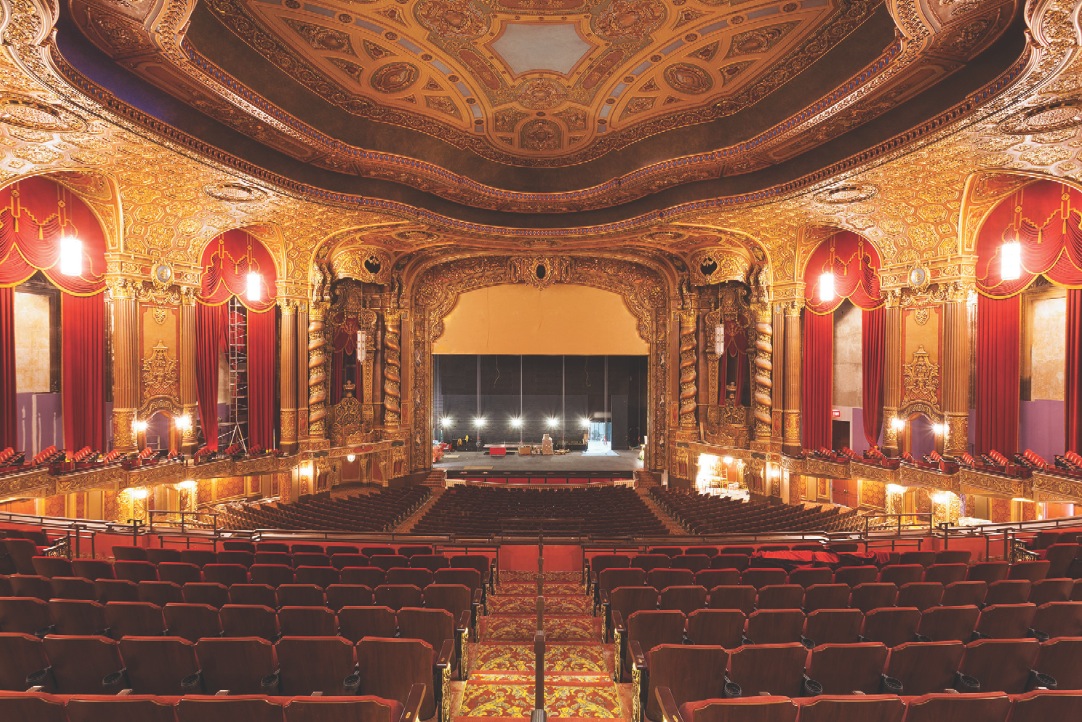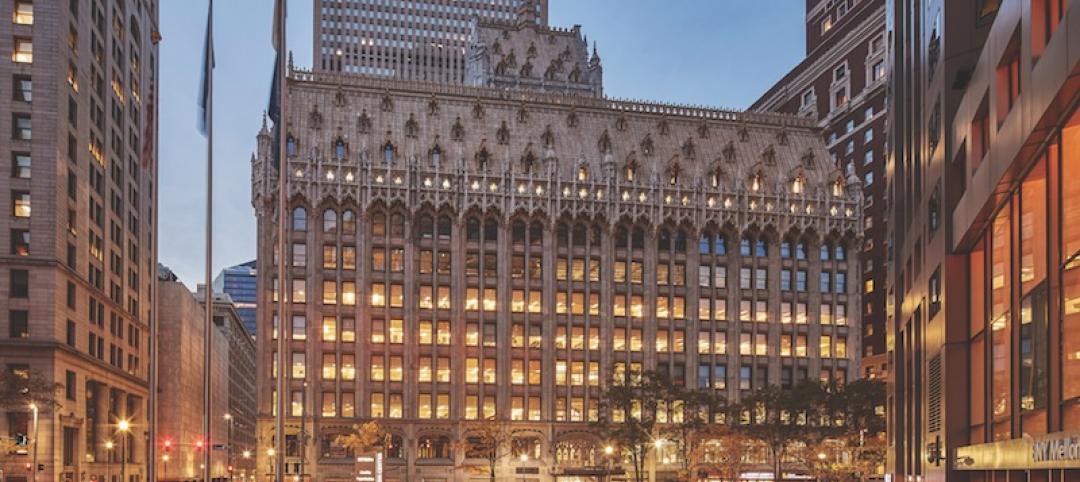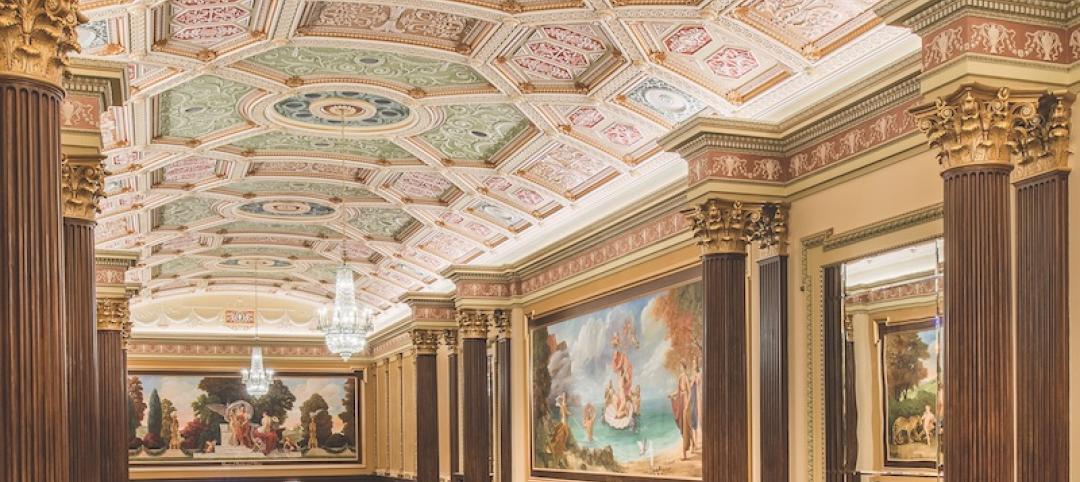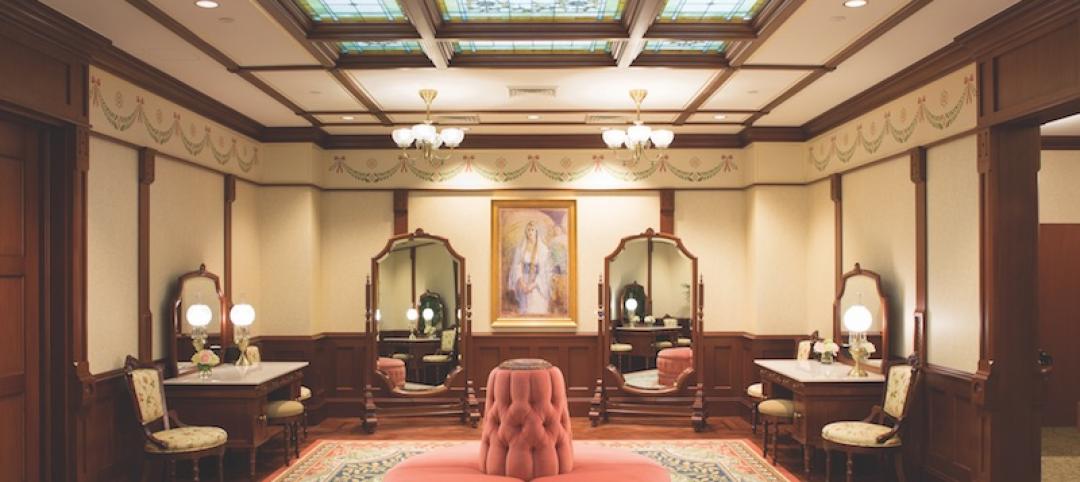When Kings Theatre opened in the Flatbush section of Brooklyn, N.Y., in 1929, it was a sight to behold. As one of five “Loew’s Wonder Theaters,” the 3,200-seat Kings Theatre was distinguished by a lavish interior that took its cue from the Palace of Versailles and the Paris Opera House. New York City’s third-largest theater offered a palatial escape to the more than 2.5 million residents of the borough of Brooklyn (Kings County).
Kings Theatre featured movies and vaudeville acts. Then, in the 1930s, vaudeville gradually faded; in the 1960s, moviegoers started gravitating to multiplexes. By the 1970s, crime and decay brought low a once-thriving Flatbush and its cornerstone three-story theater. Kings Theatre finally closed its doors in 1977. Over the next 36 years the vacant building lost whatever regal standing it once had to neglect and vandalism. Virtually every light fixture and railing was broken or stolen. Nearly two-fifths of the audience chamber suffered severe water damage. Entire sections of the mezzanine were deteriorated, corroded, or washed away. In the fall of 2012, Superstorm Sandy inflicted the coup de grâce when it ripped off the roof, leaving the domed ceiling at risk of destruction.
PLATINUM AWARD
Project Summary
KINGS THEATRE | Brooklyn, N.Y.
Building Team
Submitting firm: Gilbane Building Co. (CM)
Owner: ACE Theatrical Group
Architect: Martinez + Johnson Architecture
SE: Lundy & Franke Engineering
Civil engineer: AKRF
MEP/EOR: ICOR Consulting Engineers
Preservation/historical renovation:
EverGreene Architectural ArtsGeneral Information
Size: 109,810 sf
Construction cost: $71,656,000
Construction time: July 2012 to December 2014
Delivery method: CM at risk; design-assist
Even in its darkest hours, the theatre’s trajectory began to take a more positive path. In 2010, the New York Redevelopment Corporation chose a consortium that included ACE Theatrical Group, Goldman Sachs Urban Investment Group, and the National Development Council to bring the Kings Theatre back from the grave. ACE Theatrical Group had tackled the restoration of the Boston Opera House and the $53 million renovation of Saenger Theatre in New Orleans, which was destroyed by Hurricane Katrina.
A redevelopment team led by Martinez + Johnson Architecture and Gilbane Building Company began planning to rehabilitate and restore the movie house, while at the same time integrating equipment, technology, and support spaces to remake the grand movie palace into a venue suitable for staging live productions and events.
The primary goal: balance preservation with the creation of a modern performance space. Given the theater’s waterlogged, dilapidated condition, the first phase of the restoration required a five-month stabilization period, during which it was dried, cleaned, and made hazard free so that reconstruction could proceed in an orderly, safe manner.
The theater was undersized for the kinds of live acts and events ACE Theatrical Group wanted to book. The stage, loading dock, dressing rooms, and support facilities were deemed inadequate. To accommodate live performances, 10,000 sf of new space was added and the balcony and orchestra sections were re-raked to improve sightlines for an audience of 3,250, 424 less than in the original.
 The theater’s original marquee had been replaced by a signbox in 1949. During the latest restoration, the Building Team removed the signbox from the building and replaced it with a replica of the original. In the process, the original concave metal soffit and the recessed panels were repaired. Photo: Matt Lambros Photography.
The theater’s original marquee had been replaced by a signbox in 1949. During the latest restoration, the Building Team removed the signbox from the building and replaced it with a replica of the original. In the process, the original concave metal soffit and the recessed panels were repaired. Photo: Matt Lambros Photography.
Wherever possible, the Building Team attempted to restore the original interior components, particularly the marble and American walnut paneling, terra cotta façade, ornamental fixtures, and mosaics. The meticulous nature of this restoration was manifest in the paint analysis conducted by EverGreene Architectural Arts. The preservation consultant put countless hours into determining the authenticity of existing color schemes before selecting the right colors and finishes to restore the primary spaces to their most historically valid appearance.
This preservation ethic extended to the theater’s mechanicals. The original plan called for the installation of new MEP systems, but removing the existing ductwork would have required demolition and full replacement of intact plaster and painted ceilings, walls, ornamentation, and historical finishes. Instead, the Building Team scanned and pressure-tested existing ducts to determine their integrity, then re-engineered the HVAC system to reuse that ductwork.
The Building Team agreed that it was important to maintain the progression of spaces that would lead theater-goers from the sidewalk to the audience chamber. Consequently, the team implemented a preservation methodology to guide major treatments and interventions. Interior spaces were broken down into four zones according to their relative significance to the historic experience of the theater. Then the team developed a general restoration and rehabilitation treatment strategy to decide the most appropriate course of restorative action. Some changes were made in areas that received the highest level of significance, but interventions for highly significant spaces were kept to a minimum.
Many interior elements were damaged beyond repair and needed to be painstakingly re-created and replaced. Black-and-white photos of the theater’s details and in-field molds helped guide the project’s craftsmen. In one happy instance, a tiny strip of rug under a long-defunct popcorn machine served as the blueprint for replicating the theater’s carpeting.
Off-site fabrication of the 1920s-era plaster figurines, ornaments, and images was conducted in environmentally controlled settings and met all historic landmark requirements. (In 2012, Kings Theatre was listed on the National Register of Historic Places.)
NAVIGATING THE REGULATORY MAZE
Early on, Gilbane’s construction management crew established a relationship with the owner and architect so that the Building Team could manage its way through New York’s Byzantine building and permitting processes and regulations.
The restoration process was governed by three separate city building codes. When the theater’s existing components were being preserved, restored, or rehabilitated, the 1938 and 1968 codes took precedence; for new construction and replacement, the 2008 code prevailed.
 Kings Theatre’s original chandeliers continue to illuminate its striking lobby. Photo: Matt Lambros Photography.
Kings Theatre’s original chandeliers continue to illuminate its striking lobby. Photo: Matt Lambros Photography.
When budget constraints prevented the architect from bringing on a New York-based engineer of record, Gilbane suggested a design-assist approach that would provide the local EOR (ICOR) with the resources and information to complete the design per New York City requirements. The result was the bid and negotiation of design-assist contracts for MEP trades, ornamental plaster and paint restoration, miscellaneous metals, demolitions, and the restoration of the theater’s exterior marquee.
An additional benefit of this approach was the mutual analysis of building components, including the theater’s structural frame and envelope, the stability of its existing plaster, and the development of as-builts of existing ductwork.
Extensive use of BIM technology was integral to communicating important project information, maintaining schedules, and improving team productivity. Field information was updated regularly and synced to a master database. Subcontractors could sort and access the matters related to their scope of work and alert construction managers when those problems were resolved.
BRINGING BACK THE WONDER YEARS
Three of the former “Wonder Theatres” are now churches. The one in Jersey City, N.J., still shows movies.
But Kings Theatre stands out as the crown jewel at the center of that cluster. On February 3, 2015, a revitalized Kings Theatre reopened with its first live concert, featuring Diana Ross. The venue, Brooklyn’s second-largest after the Barclay Center, has emerged as a popular stop for performers and events. Recent shows have featured Garrison Keillor, Stephanie Mills, Josh Groban, and Jackson Browne.
The theater even offers something unheard of in New York City: free parking for 700 cars.
Hanging almost defiantly in the 50-foot-tall lobby are the theater’s original 2,000-pound chandeliers. How they managed to elude looters is a miracle.
The chandeliers serve as brilliant reminders of this theater’s luminous past, and as beacons of its future—and possibly that of Flatbush, where Kings Theatre is seen as having the potential to be a catalyst of that neighborhood’s renaissance.
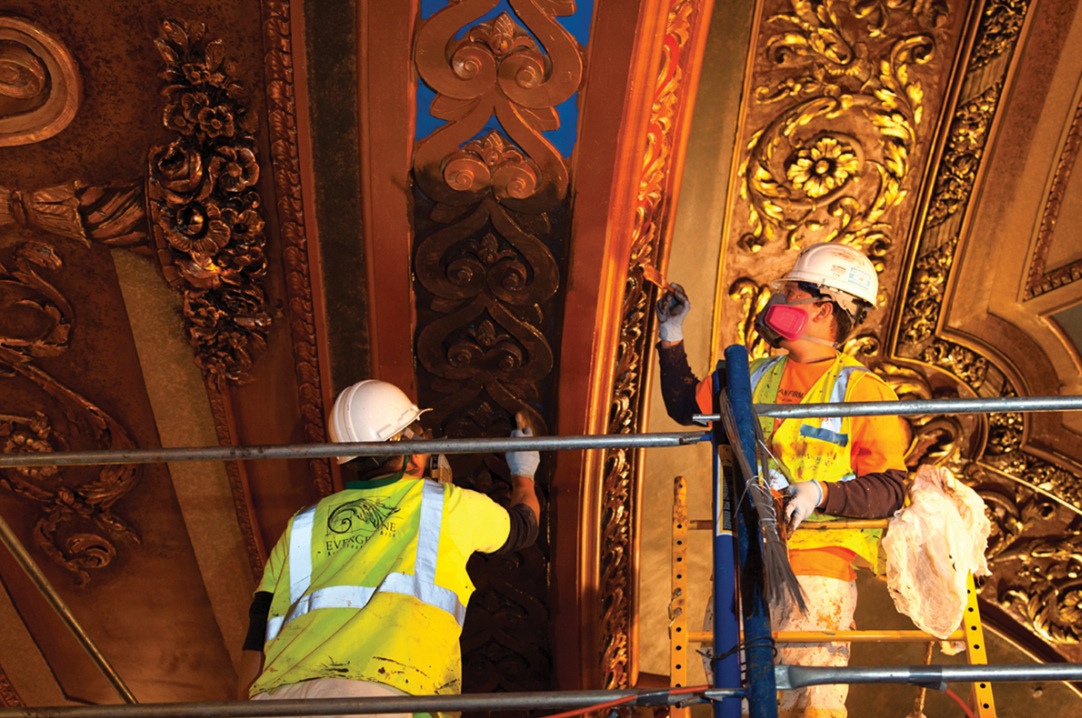 Artisans from EverGreene Architectural Arts painstakingly retain and restore the original interior wood treatments and millwork. Where deterioration of the wood was present, the material was replaced in kind, with attention to matching the texture, profile, and general appearance to the original or adjacent material. Photo: Matt Lambros Photography.
Artisans from EverGreene Architectural Arts painstakingly retain and restore the original interior wood treatments and millwork. Where deterioration of the wood was present, the material was replaced in kind, with attention to matching the texture, profile, and general appearance to the original or adjacent material. Photo: Matt Lambros Photography.
Related Stories
Reconstruction Awards | Nov 27, 2017
Patient friendly: The University of Chicago Medicine Center for Care and Discovery adds 203 new beds
Strict infection control and life safety measures were implemented to protect patients on other floors as work proceeded.
Reconstruction Awards | Nov 27, 2017
The birthplace of General Motors
The automotive giant salvages the place from which it sprang, 131 years ago.
Reconstruction Awards | Nov 21, 2017
Mama mia! What a pizzeria!: It started as a bank nearly a century ago, now it’s a pizza parlor with plenty of pizzazz
The first floor features a zinc bar and an authentic Neapolitan pizza oven.
Reconstruction Awards | Nov 21, 2017
Honor Guard: San Francisco’s historic Veterans Building pays homage to those who served in World War I and other foreign wars
The Veterans Building houses the War Memorial staff, the city’s Arts Commission, the Opera’s learning center and practice/performance node, the Green Room reception venue, and the 916-seat Herbst Theatre.
Reconstruction Awards | Nov 20, 2017
Eyes wide open: Students can see their new home’s building elements
The two-phase project revamped an opaque, horseshoe-shaped labyrinth of seven buildings from the ’60s and ’70s.
Reconstruction Awards | Nov 17, 2017
Gray lady no more: A facelift erases a landmark’s wrinkles, but not her heritage
The Building Team restored the granite and terra cotta façade and reclaimed more than 500 double-hung windows.
Reconstruction Awards | Nov 17, 2017
Elegance personified: New life for a neglected but still imposing retail/office space
The building was in such disrepair that much of the reconstruction budget had to go toward structural, mechanical, and electrical infrastructure improvements.
Reconstruction Awards | Nov 16, 2017
Back to the '20s: Coney Island gets a new eatery reminiscent of the past
This project included the restoration of the landmark Childs Restaurant.
Reconstruction Awards | Nov 15, 2017
Foyer fantastique: Faded images provide the key to a historic theater's lobby restoration
The restoration relied heavily on historic photos and drawings.
Reconstruction Awards | Nov 14, 2017
Hallowed ground: A Mormon temple rises from the ashes of a fire-ravaged historic tabernacle
Parts of the tabernacle’s exterior shell were the only things that survived the blaze.


